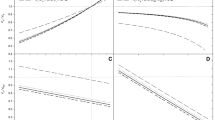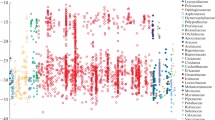Abstract
In Ceropegia dichotoma, Crassula argentea, Esheveria colorata, Kalanchoë beharensis, Opuntia ficus-indica, Sansveria stuckyi and Opuntia inermis the carbon-isotope ratio (δ 13C) of tissues close to the epidermis is 2–4.3‰ more negative than those in the centre of the leaf or cladode. The greatest change in δ 13C value occurs between the epidermal layer and the layer of mesophyll tissue immediately underneath. Analysis of major metabolic and structural components in successive layers of Crassula argentea grown under controlled environmental conditions conducive to Crassulacean acid metabolism confirmed that much of the variation in δ 13C values of bulk carbon is caused by differences in chemical composition. Thus the steep gradient in δ 13C value at the epidermis reflects, in part, the contribution of more-negative δ 13C values of lipids in these tissues. Moreover, during nocturnal CO2 fixation the amount of malic acid synthesised decreases with depth and the δ 13C value of the methanol-soluble fraction is less negative with distance away from the upper epidermis. These results are consistent with diffusion limitation to CO2 uptake in these thick leaf tissues, which also contributes to the observed gradients in δ 13C value.
Similar content being viewed by others
Abbreviations
- CAM:
-
Crassulacean acid metabolism
- FW:
-
fresh weight
- PEPCase:
-
phospoenolpyruvate carboxylase
- Rubisco:
-
ribulose-1,5-bisphosphate carboxylase-oxygenase
- δ 13C:
-
carbon-isotope ratio
References
Berry, J. A. (1989) Studies of mechanisms affecting the fractionation of carbon isotopes in photosynthesis. In: Ecological studies vol. 68: Stable isotopes in ecological research, pp. 82–94, Rundel, P.W., Ehleringer, J.R., Nagy, K.A., eds. Springer, Berlin Heidelberg New York
Deleens, E., Garnier-Dardart, J. (1977) Carbon isotope composition of biochemical fractions isolated from leaves of Bryophyllum daigremontianum Berger, a plant with Crassulacean acid metabolism: some physiological aspects related to CO2 dark fixation. Planta 135, 241–248
Deleens, E., Queiroz, O. (1984) Effects of photoperiod and ageing on the carbon isotope composition of Bryophyllum daigremontianum Berger. Plant Cell Environ. 7, 279–283
Deleens, E., Treichel, I., O'Leary, M.H. (1985) Temperature dependence of carbon isotope fractionation in CAM plants. Plant Physiol. 79, 202–206
Evans, J.R., Sharkey, T.D., Berry, J.A., Farquhar, G.D. (1986) Carbon isotope discrimination measured concurrently with gas exchange to investigate CO2 diffusion in leaves of higher plants. Aust. J. Plant Physiol. 13, 281–292
Farquhar, G.D., Ehleringer, J.R., Hubick, K.T. (1989) Carbon isotope discrimination and photosynthesis. Annu. Rev. Plant Physiol. Plant Mol. Biol. 40, 503–537
Griffiths, H., Broadmeadow, M.S.J., Borland, A.M., Hetherington, C.S. (1990) Short-term changes in carbon isotope discrimination identify transitions between C3 and C4 carboxylation during Crassulacean acid metabolism. Planta 181, 604–610
Lerman, J.C., Deleens, E., Nato, A., Moyse, A. (1974) Variation in the carbon isotope composition of a plant with Crassulacean acid metabolism. Plant Physiol. 53, 581–584
Nishida, K., Roksandic, Z., Osmond, B. (1981) Carbon isotope ratios of epidermal and mesophyll tissues from leaves of C3 and CAM plants. Plant Cell Physiol. 22, 923–926
Nobel, P.S., Hartsock, T.L. (1978) Resistance analysis of nocturnal carbon dioxide uptake by a Crassulacean acid metabolism succulent, Agave deserti. Plant Physiol. 61, 510–514
O'Leary, M.H. (1981) Carbon isotope fractionation in plants. Phytochemistry 20, 553–567
O'Leary, M.H., Osmond, C.B. (1980) Diffusional contribution to carbon isotope fractionation during dark CO2 fixation in CAM plants. Plant Physiol. 66, 931–934
Osmond, C.B., Allaway, W.G., Sutton, B.G., Troughton, J.H., Queiroz, O., Lüttge, U., Winter, K. (1973) Carbon isotope discrimination in photosynthesis of CAM plants. Nature 246, 41–42
Osmond, C.B., Bjorkman, O. (1975) Pathways of CO2 fixation in the CAM plant Kalanchoë daigremontiana II. Effects of O2 and CO2 concentration on light and dark fixation. Aust. J. Plant Physiol. 2, 155–162
Osmond, C.B., Nott, D.L., Firth, P.M. (1979) Carbon assimilation patterns and growth of the introduced CAM plant Opuntia inermis in Eastern Australia. Oecologia 40, 331–350
Parkhurst, D.F., Wong, S.C., Farquhar, G.D., Cowan, I.R. (1988) Gradients of intercellular CO2 levels across the leaf mesophyll. Plant Physiol. 86, 1032–1037
Porra, R.J., Thompson, W.A., Kriedemann, P.E. (1989) Determination of accurate extinction coefficients and simultaneous equations for assaying chlorophylls a and b extracted with four different solvents: verification of the concentration of chlorophyll standards by atomic absorption spectroscopy. Biochim. Biophys. Acta. 975, 384–394
Smith, B.N., Epstein, S. (1970) Biogeochemistry of the stable isotopes of hydrogen and carbon in salt marsh biota. Plant Physiol. 46, 738–742
Smith, S.D., Osmond, C.B. (1987) Stem photosynthesis in a desert ephemeral, Eriogonum inflatum. Morphology, stomatal conductance and water-use efficiency in field populations. Oecologia 72, 533–541
Teeri, J.A., Tonser, S.J., Turner, M. (1981) Leaf thickness and carbon isotope composition in the Crassulaceae. Oecologia 50, 367–369
Terashima I. (1989) Productive structure of a leaf. In: Photosynhesis, pp. 207–226, Briggs, W.R., ed. Alan R. Liss, Inc., New York
Vitousek, P.M., Field, C.B., Matson, P.M. (1990) Variation in foliar δ13C in Hawaiian Metrosideros polymorpha: a case of internal resistance? Oecologia 84, 362–370
Winter, K. (1987) Gradient in the degree of Crassulacean acid metabolism within leaves of Kalanchoë daigremontiana. Planta 172, 88–90
Yakir, D., Giles, L., Berry, J.A., Osmond, C.B., Thomas, R. (1993) Applications of stable isotopes to scaling biospheric photosynthetic activities. In: Scaling physiological processes: leaf to globe, Ehleringer, J.R., Field, C.B., eds. Academic Press, Orlando Fla., in press
Yakir, D., Osmond, C.B., Giles, L. (1991) Autotrophy in maize husk leaves. Evaluation using natural abundance of stable isotopes. Plant Physiol. 97, 1196–1198
Author information
Authors and Affiliations
Additional information
This work was supported by grants from the North Carolina Biotechnology Centre to Duke University, National Science Foundation (NSF) grant DCB90-06830, Department of Energy, Division of Energy Biosciences grant DE-FG05-89 ER 14005, and NSF grant BSR 87-06429 to Duke University Phytotron.
Rights and permissions
About this article
Cite this article
Robinson, S.A., Osmond, C.B. & Giles, L. Interpretations of gradients in δ13C value in thick photosynthetic tissues of plants with Crassulacean acid metabolism. Planta 190, 271–276 (1993). https://doi.org/10.1007/BF00196621
Received:
Accepted:
Issue Date:
DOI: https://doi.org/10.1007/BF00196621




